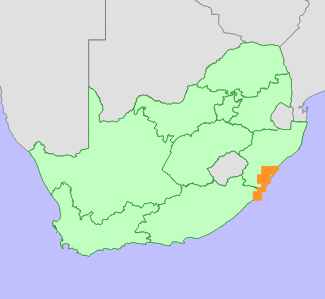|
Scientific Name | Helichrysum pannosum DC. |
Higher Classification | Dicotyledons |
Family | ASTERACEAE |
National Status |
Status and Criteria | Endangered A2c |
Assessment Date | 2009/06/23 |
Assessor(s) | L. von Staden |
Justification | A population reduction of at least 50% is estimated based on 55.4% habitat loss in the past 90 years, mainly due to cultivation of sugarcane and other crops, urban and coastal development and alien plant invasion, and it is suspected to be locally extinct north of Durban due to more than 90% habitat loss in that part of its range. The generation length of this resprouting grassland forb is estimated to be 30 years. Although still fairly common in remaining suitable habitat, this species is expected to continue to decline as a result of ongoing habitat loss and degradation. |
Distribution |
Endemism | South African endemic |
Provincial distribution | Eastern Cape, KwaZulu-Natal |
Range | KwaZulu-Natal and Eastern Cape coast, from Stanger southwards to Port St Johns. Also occurs further inland around Durban to Pinetown and Camperdown. |
Habitat and Ecology |
Major system | Terrestrial |
Major habitats | KwaZulu-Natal Sandstone Sourveld, KwaZulu-Natal Hinterland Thornveld, Midlands Mistbelt Grassland, Moist Coast Hinterland Grassland, Dry Coast Hinterland Grassland, Scarp Forest, KwaZulu-Natal Coastal Belt Thornveld, Pondoland-Ugu Sandstone Coastal Sourveld, KwaZulu-Natal Coastal Belt Grassland |
Description | Grassland, often on hill slopes near forest patches. |
Threats |
| The habitat of this taxon is more than 55% transformed (calculated using GIS), mainly as a result of sugarcane cultivation, urban and coastal development around Durban and the KwaZulu-Natal south coast. Degradation mainly due to overgrazing, forestry plantations, cultivation of other crops and alien plant invasion. Although it is still fairly common in suitable habitat, it is likely to continue to decline due to ongoing habitat loss to urban expansion, alien plant invasion, overgrazing and ongoing degradation of small grassland fragments due to lack of fire. Larger grassland areas are likely to be suffering ongoing degradation as a result of too frequent fire, particularly in areas where grasslands are utilized for grazing, such as the southern parts of the range of this species. |
Population |
Population trend | Decreasing |
Assessment History |
Taxon assessed |
Status and Criteria |
Citation/Red List version | | Helichrysum pannosum DC. | Least Concern | Raimondo et al. (2009) | |
Bibliography |
Hilliard, O.M. 1983. Gnaphaliinae (First Part). In: O.A. Leistner (ed). Flora of Southern Africa 33 Asteraceae, Part 7 Inuleae, Fascicle 2:1-325. National Botanical Institute, Pretoria.
Raimondo, D., von Staden, L., Foden, W., Victor, J.E., Helme, N.A., Turner, R.C., Kamundi, D.A. and Manyama, P.A. 2009. Red List of South African Plants. Strelitzia 25. South African National Biodiversity Institute, Pretoria.
|
Citation |
| von Staden, L. 2009. Helichrysum pannosum DC. National Assessment: Red List of South African Plants version 2024.1. Accessed on 2025/12/10 |
 Comment on this assessment
Comment on this assessment


